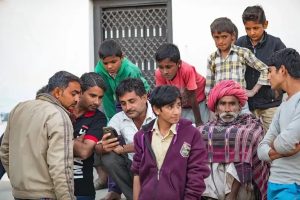Using smartphone-based applications: Some challenges faced by farmers

Over the last 4 months, we have been working on ground in Uttar Pradesh, Karnataka and Nagaland, in order to understand the role of product/interface design and other factors that influence and enhance the usability of smartphone based agri/financial services. In previous posts, we laid out the context, and our findings from an initial assessment of the app-ecosystem in our study areas. We also highlighted three lesser considered aspects, as far as adoption and usage are concerned (form and type of information, the gender gap, and how the current landscape of applications fare in terms of design).
With the number of applications available in the market that cater to financial and market linkages for farmers in rural segments, ensuring ease of learning is paramount. As a next step in our study, we explore how end-users learn a new application, and whether skills acquired (navigational, transactional, procedural) are transferable across applications. Through extensive classroom and individual training sessions, we observed the key stages participants went through in learning a new app, noted decisions taken and errors made, and then tested whether participants were able to use a different app with which they were not familiar. Subsequently, in this blog we highlight some of our preliminary impressions on factors that affect user learning and experience.
1) Design (Navigation): One of the most basic challenges observed thus far pertains to navigating a given app-based service. On the whole, there are a number of dimensions to these challenges, as outlined below:
- Screen/ icons: apps where all functions could be accessed from a single screen appeared to be easier and more intuitive to use, as opposed to apps where multiple screens, and multiple navigation choices were involved.
- Use of voice: a large number of respondents interviewed in Uttar Pradesh appeared to rely on mic/ voice features of Android phones in order to complete small tasks such as searching for apps on Play Store. As voice computing becomes more and more feasible and popular across the world and India, it perhaps thus offers a solution to overcome various challenges of ICT/ digital literacy in rural areas.
2) Trust, comfort with technology, and affordances: One of the prominent gaps in both research and practice in the agri/financial app space remains the question of what ‘hooks’ might work best for low income segments to adopt digital technologies and services. However, from our fieldwork, we observe a persistent lack of trust in this regard. This appears to arise from a lack of understanding on the range of capabilities of a smartphone, knowledge of the internet and its workings, and little to no understanding of passwords and encryption. At the same time, it is peculiar that apps such as Whatsapp and Youtube are commonly used by the same respondents, despite the same literacy constraints.
In other contexts, researchers have used a framework drawn from Gibbon’s [1] theory of affordances to analyse similar issues and examine why some technologies are perceived as being more intuitive to use than others. For example, Wyche and Steinfeld (2016)[2] identify “a mismatch between the design of MIS (Market Information System) and smallholder farmers’ perceptions of their mobile phones’ communication capabilities”, in their study on Mfarm — a commercial agri-service available in rural Kenya. They conclude by highlighting the need for a design agenda drawing on an “ecological perspective when creating mobile applications for sub-Saharan Africa’s rural farmers”. While challenging, the need of the hour in the Indian context (for both research and industry) is to ensure that a comprehensive and detailed understanding of end-consumer needs, capabilities and perceptions is integrated into product design.
3) Robustness of technological infrastructure: While infrastructure/ connectivity issues are fast improving, there is still plenty to be done if the mass adoption and usage of app-based services is to be achieved. In our fieldwork, we observed delays in receiving SMS/ OTP (during app registration), and poor internet connectivity in parts of our study areas. While these issues are indeed being resolved as service providers improve network and connectivity, these factors also play a key role in building trust and comfort of the user.
4) Age: Across the board, older segments of population faced significant challenges in using the various smartphone based services we tested. In multiple instances, we found that older farmers often either refrained from using smartphone based services due to a lack of familiarity, or relied on their educated children to help them. It is already well known that sections of the population working in agriculture are older on average than those in other sectors. This presents an important factor to keep in mind, as each of the various factors listed above interact with age, thereby significantly compounding the challenges faced when ensuring that products are designed ‘inclusively’.
In our next blog in this series, we hope to unpack the specific app features that enable and hinder usage, shed light on more effective methods for end user learning and share key actionable points for stakeholders in this space.
References
[1] Gibbons, James J. “The Theory of Affordances” The Ecological Approach to Visual Perception. Boston: Houghton Mifflin, 1979.
[2] Wyche, S., & Steinfeld, C. (2015). Why Don’t Farmers Use Cell Phones to Access Market Prices? Technology Affordances and Barriers to Market Information Services Adoption in Rural Kenya. Infromation Technology for Development.
This research was developed as part of the Bharat Inclusion Research Fellowship.
